
Tooth Formation and Development
When babies are born, there are no teeth visible in their mouth. However, their primary teeth are already partially formed into the jaws but remain under the gums. They will begin to erupt in the mouth one by one when the baby becomes about six months to a year old.
The process of tooth development
The formation of teeth usually begins around the sixth week of embryo development. Teeth are created with the differentiation of epithelium cells of the mouth.
The tooth formation process is divided in three main stages:
Growth period »
Calcification period »
Eruption period
1. Growth Period
After the sixth week of pregnancy, some epithelium (skin) cells of the mouth, located along the ridge of the developing jaws, start to differentiate and thicken creating a band of cells called ‘dental lamina’. These cells will form later the different parts of the tooth.
The growth period is divided into three sub-periods: bud stage, cap stage, and bell stage. They are named based on the shape of the group of cells involved in tooth formation.
Bud Stage
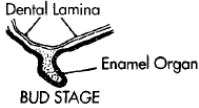 As soon as the dental lamina is formed, groups of epithelium cells start to grow into the underlying tissue, each group representing a tooth bud (or enamel organ) located at the approximate position of each deciduous tooth.
Twenty of these tooth buds will create the 20 primary teeth (10 at each jaw).
As soon as the dental lamina is formed, groups of epithelium cells start to grow into the underlying tissue, each group representing a tooth bud (or enamel organ) located at the approximate position of each deciduous tooth.
Twenty of these tooth buds will create the 20 primary teeth (10 at each jaw).
At the time of birth some of the tooth buds that will create much later the permanent teeth are already formed. The formation of permanent dentition tooth buds starts around the fifth month of pregnancy (for the central incisors) and will be completed at the age of 5 years (for the third molars).
Cap Stage
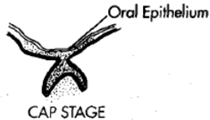
At this stage of tooth formation the cells of the tooth buds continue to grow and multiply, gradually giving to the formation the shape of a hollowed cap.
The epithelium of the will later form the enamel, dentin, and cementum while the area under the cap, which is called the dental papilla, will form the dental pulp.
Bell Stage
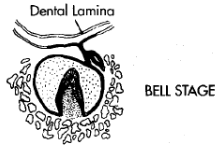 At the next stage of tooth development a concavity is formed along the inner surface of the cap, which transforms into a bell shaped organ.
The tooth bud cells differentiate into enamel-forming ameloblasts and dentin-producing odontoblasts which line up on a boundary line called dentinoenamel junction.
At the next stage of tooth development a concavity is formed along the inner surface of the cap, which transforms into a bell shaped organ.
The tooth bud cells differentiate into enamel-forming ameloblasts and dentin-producing odontoblasts which line up on a boundary line called dentinoenamel junction.
The odontoblasts form a matrix of collagen fibres called predentin that subsequently will be calcified to become dentin. Near the end of the bell stage, the developing tooth structure becomes completely separated from the epithelium of the mouth and the root formation starts.
2. Calcification Period (or Crown Stage)
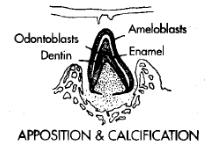
The next stage of tooth development is calcification. At this point the tooth has already taken a recognizable shape.
After the odontoblasts have started to create dentin (dentinogenesis), the ameloblasts initiate the formation of the enamel (amelogenesis). Some of the cells surrounding the dental pulp at the area of the root differentiate into cementoblasts which start to create cementum around the tooth’s root, while other dental follicle cells create the periodontal tissues such as the fibrous periodontal ligament that connects the tooth with the alveolar socket.
During the calcification stage the organic matrix that will form the hard dental structures (enamel, dentin, cementum) becomes hardened by the deposition of calcium and mineral salts. Finally, additional layers of enamel are added to the outer surface of the developing tooth from the top of the crown towards the cementonenamel junction. When fully calcified, the enamel consists of approximately 95% minerals.
3. Eruption Period
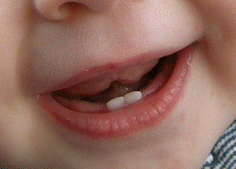 The final stage of tooth development is the eruption of tooth into the mouth through the gum layer. After the crown is formed, the tooth starts moving slowly towards the surface of the jaw.
For permanent teeth, this process from crown completion until they emerge into their assigned position in the mouth may take up to 3 years.
The completion of the root formation may continue after the tooth eruption, for about one year for primary teeth up to several years for permanent teeth.
The final stage of tooth development is the eruption of tooth into the mouth through the gum layer. After the crown is formed, the tooth starts moving slowly towards the surface of the jaw.
For permanent teeth, this process from crown completion until they emerge into their assigned position in the mouth may take up to 3 years.
The completion of the root formation may continue after the tooth eruption, for about one year for primary teeth up to several years for permanent teeth.
Tooth eruption for primary teeth occurs between 6 months and 3 years of age, a period that can be very frustrating for the baby, known as teething. The permanent teeth erupt between 6 and 13 years of age with the exception of third molars (wisdom teeth) which erupt much later after adolescence.
Before the permanent incisors, canines and premolars can erupt, the primary teeth that occupy their position in the mouth must fall out first. This is achieved through a process called exfoliation, when the roots of the primary teeth dissolve until the tooth weakens and falls out.


